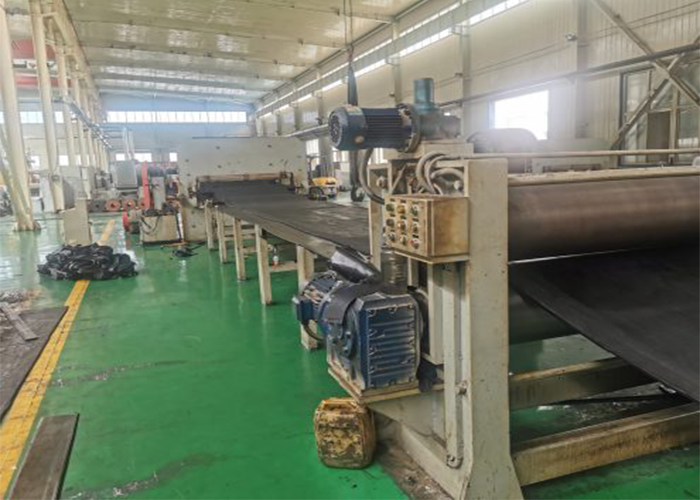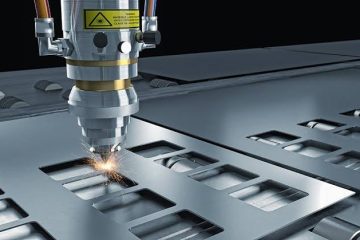Mining conveyor belts are critical components in the mining industry, serving as the backbone for material transport across both surface and underground operations. These belts facilitate the efficient movement of raw materials from the extraction site to the processing areas, significantly reducing the manpower and time traditionally required for material handling. Their ability to operate continuously and handle a vast range of materials—from fine particles like sand to large, coarse rocks—enhances productivity and operational efficiency. Moreover, the strategic use of conveyor belts helps in minimizing transportation costs and environmental impact by reducing the reliance on truck haulage, thereby underscoring their indispensable role in modern mining operations.
Types of Mining Conveyor Belts
In the mining industry, the choice of conveyor belt can significantly affect the efficiency, safety, and cost of operations. Here, we explore and compare the common types of conveyor belts used in mining, focusing on steel cord, nylon, and other varieties.
Steel Cord Conveyor Belts
Steel cord conveyor belts are renowned for their high tensile strength and excellent durability. Constructed with steel wires embedded in a rubber matrix, they are designed to carry heavy loads over long distances with minimal stretch. This makes them ideal for the open pit mining environment, where belts must cover considerable distances between the mine face and processing plants. However, their heavy construction can increase power consumption, and their rigidity sometimes limits their use in scenarios requiring belts to navigate sharp curves or steep inclines.
Nylon Conveyor Belts
Nylon conveyor belts, made from synthetic nylon fiber, are valued for their flexibility and strength. These belts are lighter than steel cord belts and offer excellent resistance to various environmental factors like abrasion, impact, and moisture. Their flexibility allows for smaller pulley diameters and tight turns, making them well-suited for complex routes typical in underground mining operations. While not as ideal for extremely long-distance transport as steel cord belts, nylon belts are more energy-efficient and cost-effective for many mining applications.
Other Types of Conveyor Belts
Multi-ply Belts: Composed of several layers of fabric material covered by rubber, multi-ply belts are versatile and can be used in a variety of mining scenarios. They are particularly useful for shorter distance transportation and can handle moderate load sizes. The flexibility of the fabric layers allows these belts to manage small to medium-sized pulleys and moderate inclines.
PVC Belts: PVC conveyor belts are a good choice for underground mining. These belts are flame retardant, which is a critical safety feature in environments where the risk of fire is a concern. They also resist chemicals and oils and have good abrasion resistance, though they are generally less durable under heavy load conditions compared to steel cord or nylon belts.
Chevron Conveyor Belts: Featuring a surface pattern of raised sections known as “chevrons,” these belts are tailored for transporting bulk materials at higher angles of incline without risk of slippage. This feature is particularly beneficial in hilly terrain or where space constraints prevent the construction of standard flat belt conveyor systems.
The selection of a conveyor belt in the mining industry depends on a variety of factors, including the distance materials need to travel, the environmental conditions, the nature of the materials transported, and specific operational needs. Each type of belt—whether steel cord, nylon, multi-ply, PVC, or chevron—offers distinct advantages and limitations, making the understanding of their characteristics crucial for optimal selection and use.
Selection Criteria for Mining Conveyor Belts
Choosing the right conveyor belt for mining operations is critical to ensure safety, efficiency, and cost-effectiveness. The selection process involves a comprehensive assessment of several key factors, which include the tensile strength, environmental conditions, and the nature of the materials being transported. Each of these factors plays a crucial role in determining the suitability of a conveyor belt for specific mining tasks.
Tensile Strength
Tensile strength is a primary consideration when selecting a mining conveyor belt. It determines the belt’s ability to handle the operational load without breaking or stretching unduly. Belts with higher tensile strength are essential for transporting heavy loads over long distances, as commonly seen in open-pit mining. Steel cord conveyor belts are often preferred in such scenarios for their superior strength and minimal elongation. Conversely, for shorter distances and lighter loads, nylon or multi-ply belts may provide adequate strength and more cost-efficiency.
Environmental Conditions
The environmental conditions of the mining site significantly influence the choice of conveyor belt. Factors such as temperature extremes, moisture, exposure to oils, chemicals, and UV light can deteriorate a belt’s material unless properly suited to the conditions. For instance, PVC belts are favored in underground mining not only for their fire-retardant properties but also for their resistance to oils and chemicals. Similarly, in humid or wet conditions, belts with better water resistance, like rubber-coated nylon belts, are advantageous to prevent slippage and degradation.
Nature of Materials Transported
The characteristics of the materials being transported also dictate the type of conveyor belt needed. Abrasive materials such as ores and minerals require belts with high abrasion resistance to extend their lifespan and reduce maintenance needs. Belts like nylon are advantageous here for their durability against wear and tear. Additionally, the size and shape of the material particles are important; sharp-edged materials might necessitate belts with reinforced coverings to prevent cuts and punctures.
Additional Considerations
Load Impact: Belts must be selected based on their ability to absorb impact at loading points. Belts with reinforced shock absorption capabilities are critical in reducing damage from large, heavy materials dropped from a height.
Conveyor Length and Configuration: The total length of the conveyor and the presence of curves, inclines, or declines influence belt selection. Flexible belts like nylon are suitable for complex configurations with tight curves, whereas long straight runs might benefit from the low-stretch characteristics of steel cord belts.
Operational Speed: High-speed conveyors require belts with excellent dynamic properties to withstand the forces exerted by rapid movement. High-tensile, low-stretch belts are generally preferred to ensure stability and reduce wear under high-speed conditions.
Selecting the right conveyor belt for mining operations requires a balanced consideration of these factors. The decision involves not only matching the belt’s properties with the operational requirements but also ensuring that the belt can withstand the specific environmental challenges of the mining site. This careful selection process is essential to optimize both operational efficiency and safety in mining conveyor systems.
Maintenance and Safety
Maintaining mining conveyor belts and ensuring safety during operations are critical components of effective mining management. Regular maintenance not only prolongs the lifespan of the conveyor belts but also enhances their reliability and efficiency. Here, we discuss the best practices for maintaining these systems and ensuring safety in their operation.
Regular Inspection and Monitoring
Regular inspections are fundamental to maintaining the integrity of conveyor belts. These inspections should cover all components of the conveyor system, including belts, rollers, pulleys, motors, and electrical connections. Special attention should be given to the belt’s alignment and tension to prevent uneven wear and potential failures. Monitoring systems can also be installed to continuously check the belt’s performance and condition, alerting operators to any anomalies like tears or misalignments that could indicate emerging issues.
Preventive Maintenance
Preventive maintenance involves scheduled checks and replacement of worn or damaged parts before they fail. This approach helps in avoiding unexpected downtime and costly repairs. Critical areas to focus on include:
Belt tensioning: Ensuring that the belt is neither too tight nor too loose can prevent slippage and excessive wear.
Lubrication: Bearings and other moving parts require regular lubrication to minimize friction and wear.
Cleaning: Removal of debris and residues from the belt and rollers helps prevent damage and maintains the efficiency of the belt’s movement.
Safety Protocols
Safety is paramount in the operation of mining conveyor belts. Implementing robust safety protocols and training for all personnel involved in the operation and maintenance of the conveyor system is crucial. Key safety practices include:
Emergency stops: Conveyor systems should be equipped with easily accessible emergency stop mechanisms along the length of the conveyor.
Guarding: Moving parts should be properly guarded to prevent accidental contact.
Signage and barriers: Adequate signage and physical barriers should be used to warn about the dangers and restrict access to the conveyor areas.
Use of Advanced Technology
Incorporating advanced technology can significantly aid in both maintenance and safety. Technologies like predictive analytics and condition monitoring can preemptively identify potential issues before they lead to failures, thereby maintaining continuous operation and enhancing safety. These technologies monitor variables such as belt tension, speed, and temperature to ensure optimal performance and trigger maintenance actions when needed.
Training and Awareness
Regular training and safety drills are essential for personnel to understand the operational and safety aspects of conveyor belts. Training should cover:
Operational procedures: Ensuring all operators understand how to safely start, run, and stop the conveyor.
Maintenance practices: Educating maintenance staff on proper inspection and repair techniques.
Emergency response: Training all staff on what to do in case of an emergency, such as a belt malfunction or a fire.
Maintaining mining conveyor belts and ensuring safety requires a comprehensive approach that includes regular inspections, preventive maintenance, the use of advanced technologies, and thorough training and safety protocols. These practices not only extend the life of the conveyor belts but also protect the health and safety of all workers involved in their operation.
Innovations in Conveyor Belt Technology
The mining industry continuously seeks improvements in conveyor belt technology to enhance efficiency, safety, and environmental sustainability. Recent innovations in conveyor belt materials and design not only address these goals but also extend the operational lifespan and reduce maintenance needs. Here, we explore some of the latest advancements in conveyor belt technology.
Advanced Materials
The development of new materials has significantly impacted the performance of conveyor belts in mining. High-performance polymers, for example, offer improved wear resistance and longevity compared to traditional rubber belts. These materials are engineered to withstand harsh mining environments, reducing the frequency of belt replacements and maintenance interventions.
Thermoplastic Polyurethane (TPU): Known for its exceptional abrasion resistance and tear strength, TPU is becoming increasingly popular for conveyor belts. It also possesses excellent chemical resistance, making it suitable for mines where the conveyor is exposed to oils, greases, and other harsh substances.
Aramid Fibers: Used in the reinforcement of conveyor belts, aramid fibers provide high strength at low weight, which significantly reduces the energy consumption of the conveyor systems. Belts reinforced with aramid fibers are not only durable but also easier to handle and install.
Smart Conveyor Belts
Technological integration has led to the development of “smart” conveyor belts equipped with sensors and monitoring systems. These belts are capable of real-time data transmission regarding their health and operational status, enabling predictive maintenance strategies. This can lead to a drastic reduction in downtime and better resource management.
Embedded Sensors: Sensors embedded in the conveyor belt monitor variables like temperature, belt alignment, and wear condition. This continuous monitoring helps in anticipating failures before they occur, ensuring timely maintenance actions.
RFID Technology: Radio Frequency Identification (RFID) tags embedded in conveyor belts help in tracking the belt’s usage and wear over time. This data is crucial for optimizing maintenance schedules and improving the overall lifecycle management of the conveyor system.
Eco-friendly Designs
With increasing environmental awareness, the mining industry is adopting more sustainable practices. Conveyor belts are no exception, with innovations aimed at reducing the environmental impact.
Recycled Materials: Some conveyor belts are now made using recycled plastics and rubber, reducing the need for virgin raw materials and lowering the carbon footprint associated with the production of new belts.
Energy-efficient Designs: Advances in belt design, such as improved belt geometry and reduced belt weight, contribute to lower energy consumption during operation. These designs require less power to move the same amount of material, thereby reducing the overall energy costs of mining operations.
Enhanced Safety Features
Safety remains a paramount concern in conveyor belt design. Innovations aimed at improving safety include:
Anti-rip and Anti-tear Technologies: New types of conveyor belts are equipped with features that prevent cuts and tears from propagating. This is crucial in mining, where sharp objects and heavy loads can cause significant damage to the belt.
Fire-resistant Materials: Advances in materials science have led to the development of fire-resistant belts that can withstand high temperatures and reduce the risk of fire in mines, particularly in underground settings where such risks are higher.
The innovations in conveyor belt technology are diverse, focusing on enhancing material properties, integrating smart technologies, promoting sustainability, and improving safety. These advancements are critical for meeting the evolving demands of the mining industry, optimizing operations, and ensuring environmental compliance.



